Managerial Economics Report: Exploring Behavioral Economics Theories
VerifiedAdded on 2022/12/28
|9
|3086
|1
Report
AI Summary
This report provides an overview of behavioral economics, a field that combines economics and psychology to understand decision-making. It delves into core cognitive theories, including prospect theory, which explains how individuals make choices under risk and uncertainty, and bounded rationality, which highlights the limitations of rational decision-making due to cognitive constraints, time, and information. The report also examines nudge theory, which explores how subtle changes in choice architecture can influence behavior, and mental accounting, which explains how people categorize and evaluate money. Furthermore, the report discusses search heuristics and their impact on economic choices. The analysis incorporates real-world examples, providing insights into the practical implications of these theories and their role in shaping economic behavior.
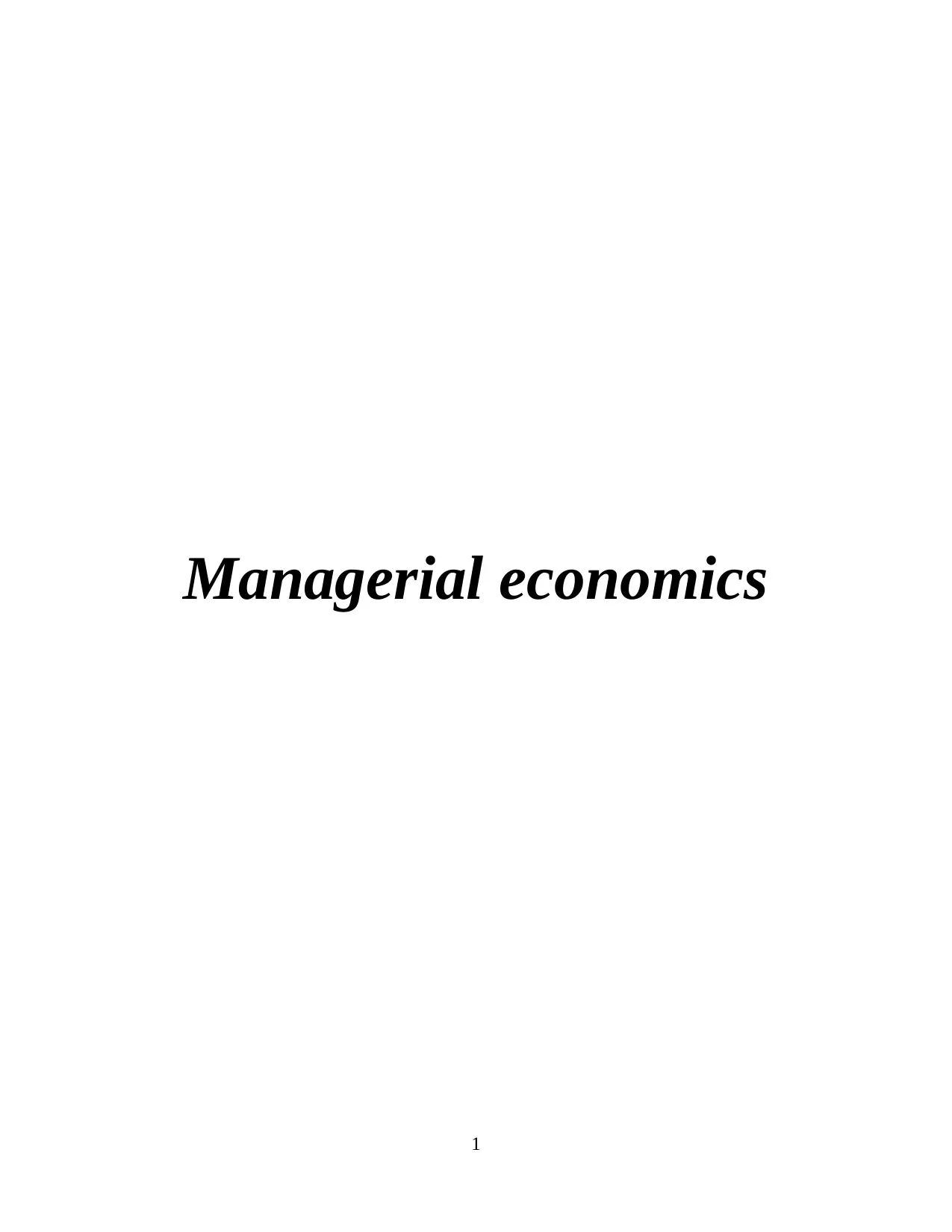
Managerial economics
1
1
Paraphrase This Document
Need a fresh take? Get an instant paraphrase of this document with our AI Paraphraser
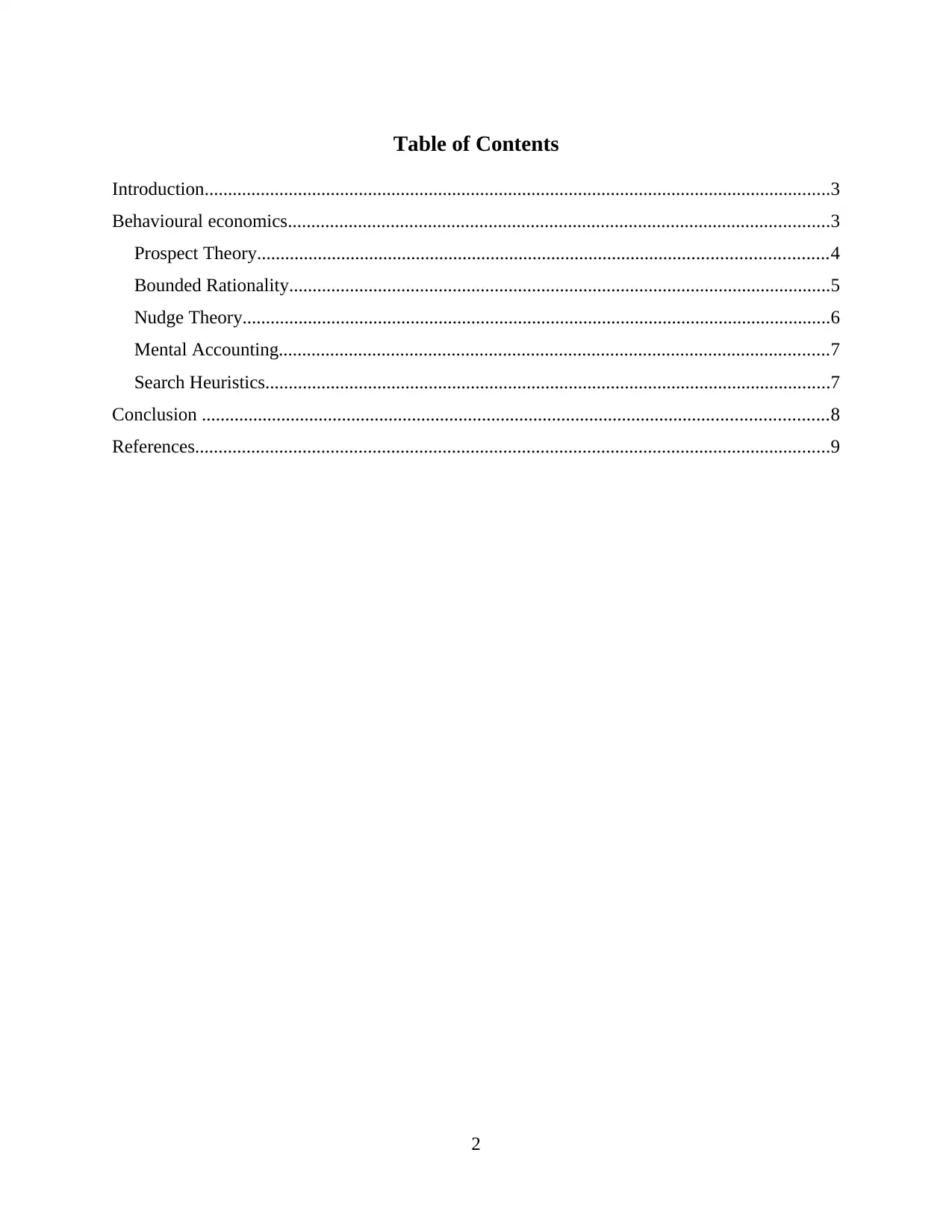
Table of Contents
Introduction......................................................................................................................................3
Behavioural economics....................................................................................................................3
Prospect Theory..........................................................................................................................4
Bounded Rationality....................................................................................................................5
Nudge Theory..............................................................................................................................6
Mental Accounting......................................................................................................................7
Search Heuristics.........................................................................................................................7
Conclusion ......................................................................................................................................8
References........................................................................................................................................9
2
Introduction......................................................................................................................................3
Behavioural economics....................................................................................................................3
Prospect Theory..........................................................................................................................4
Bounded Rationality....................................................................................................................5
Nudge Theory..............................................................................................................................6
Mental Accounting......................................................................................................................7
Search Heuristics.........................................................................................................................7
Conclusion ......................................................................................................................................8
References........................................................................................................................................9
2
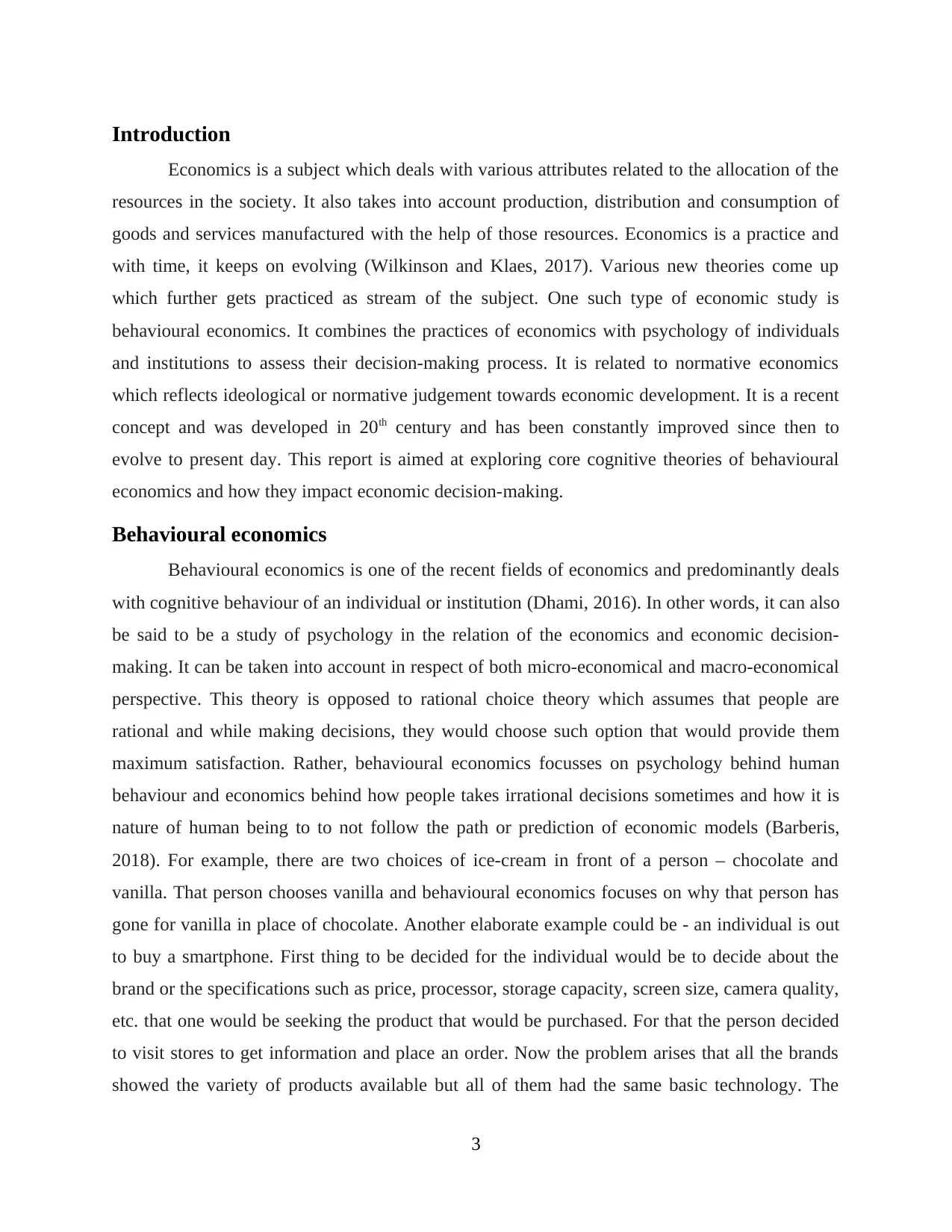
Introduction
Economics is a subject which deals with various attributes related to the allocation of the
resources in the society. It also takes into account production, distribution and consumption of
goods and services manufactured with the help of those resources. Economics is a practice and
with time, it keeps on evolving (Wilkinson and Klaes, 2017). Various new theories come up
which further gets practiced as stream of the subject. One such type of economic study is
behavioural economics. It combines the practices of economics with psychology of individuals
and institutions to assess their decision-making process. It is related to normative economics
which reflects ideological or normative judgement towards economic development. It is a recent
concept and was developed in 20th century and has been constantly improved since then to
evolve to present day. This report is aimed at exploring core cognitive theories of behavioural
economics and how they impact economic decision-making.
Behavioural economics
Behavioural economics is one of the recent fields of economics and predominantly deals
with cognitive behaviour of an individual or institution (Dhami, 2016). In other words, it can also
be said to be a study of psychology in the relation of the economics and economic decision-
making. It can be taken into account in respect of both micro-economical and macro-economical
perspective. This theory is opposed to rational choice theory which assumes that people are
rational and while making decisions, they would choose such option that would provide them
maximum satisfaction. Rather, behavioural economics focusses on psychology behind human
behaviour and economics behind how people takes irrational decisions sometimes and how it is
nature of human being to to not follow the path or prediction of economic models (Barberis,
2018). For example, there are two choices of ice-cream in front of a person – chocolate and
vanilla. That person chooses vanilla and behavioural economics focuses on why that person has
gone for vanilla in place of chocolate. Another elaborate example could be - an individual is out
to buy a smartphone. First thing to be decided for the individual would be to decide about the
brand or the specifications such as price, processor, storage capacity, screen size, camera quality,
etc. that one would be seeking the product that would be purchased. For that the person decided
to visit stores to get information and place an order. Now the problem arises that all the brands
showed the variety of products available but all of them had the same basic technology. The
3
Economics is a subject which deals with various attributes related to the allocation of the
resources in the society. It also takes into account production, distribution and consumption of
goods and services manufactured with the help of those resources. Economics is a practice and
with time, it keeps on evolving (Wilkinson and Klaes, 2017). Various new theories come up
which further gets practiced as stream of the subject. One such type of economic study is
behavioural economics. It combines the practices of economics with psychology of individuals
and institutions to assess their decision-making process. It is related to normative economics
which reflects ideological or normative judgement towards economic development. It is a recent
concept and was developed in 20th century and has been constantly improved since then to
evolve to present day. This report is aimed at exploring core cognitive theories of behavioural
economics and how they impact economic decision-making.
Behavioural economics
Behavioural economics is one of the recent fields of economics and predominantly deals
with cognitive behaviour of an individual or institution (Dhami, 2016). In other words, it can also
be said to be a study of psychology in the relation of the economics and economic decision-
making. It can be taken into account in respect of both micro-economical and macro-economical
perspective. This theory is opposed to rational choice theory which assumes that people are
rational and while making decisions, they would choose such option that would provide them
maximum satisfaction. Rather, behavioural economics focusses on psychology behind human
behaviour and economics behind how people takes irrational decisions sometimes and how it is
nature of human being to to not follow the path or prediction of economic models (Barberis,
2018). For example, there are two choices of ice-cream in front of a person – chocolate and
vanilla. That person chooses vanilla and behavioural economics focuses on why that person has
gone for vanilla in place of chocolate. Another elaborate example could be - an individual is out
to buy a smartphone. First thing to be decided for the individual would be to decide about the
brand or the specifications such as price, processor, storage capacity, screen size, camera quality,
etc. that one would be seeking the product that would be purchased. For that the person decided
to visit stores to get information and place an order. Now the problem arises that all the brands
showed the variety of products available but all of them had the same basic technology. The
3
⊘ This is a preview!⊘
Do you want full access?
Subscribe today to unlock all pages.

Trusted by 1+ million students worldwide

factors that would decide for the final decision of the buyer would be the customisation features
asked and that would be area of concern of the behavioural economics. One such factor is the
way of presentation of the products i.e. how the product is presented will influence the final
purchase of the buyer (Wendel, 2020). There are various underlying concepts related to
behavioural economics in it such as default choice i.e. more the uncertain customer is in taking
final decision, more likely is this point that it will go by default choice, especially if it gets
presented to customers as recommended configuration. Second is, option to frame choices by
sellers i.e. different sellers can project their product as different by highlighting or concealing
their attributes to manipulate the decision-making process of the customer. Another factor is the
anchor such as price, that is able to influence value of the product in the mind of customer and
can be deciding factor the final decision-making like individual will definitely like the price tag
of £1500 over the price tag of £2000. There are various theories related to behavioural
economics which was initially developed in 20th century and have been constantly improved in
21st century. Below mentioned are various concepts and theories related to behavioural
economics:
Prospect Theory
Economic theories in the earlier times were based on rational choice theory which
assumed ideal world in which consumers know their exact needs and wants and had the
capabilities to make rational decisions. They believed that consumers have stable preferences
and indulge in such behaviour that optimise their value addition from that choice. Prospect
theory was on the opposing side of rational choice theory. It was developed by Amos Tversky
and Daniel Kahneman. They asserts that consumer decision-making is not always ideal. They
change according to the context like opportunity cost (Corr and Plagnol, 2018). This theory deals
with and tries to explain the biases that people often make when they are to make certain
decisions – certainty, isolation effect and loss aversion. For example, ideal choice says that
consumers always prefer the best for them but that is not necessarily the case always as
sometimes to avail the best choice in general, one consumer has to leave another option which
might be not be general best but suiting the specified consumer perfectly. So, that consumer
leaves the best choice to choose another option. In other words, consumers' willingness to take
risks depends upon the choices framed in front of them for pain of giving something up is more
than pleasure derived from receiving it. For example there are two choices of lottery in front of
4
asked and that would be area of concern of the behavioural economics. One such factor is the
way of presentation of the products i.e. how the product is presented will influence the final
purchase of the buyer (Wendel, 2020). There are various underlying concepts related to
behavioural economics in it such as default choice i.e. more the uncertain customer is in taking
final decision, more likely is this point that it will go by default choice, especially if it gets
presented to customers as recommended configuration. Second is, option to frame choices by
sellers i.e. different sellers can project their product as different by highlighting or concealing
their attributes to manipulate the decision-making process of the customer. Another factor is the
anchor such as price, that is able to influence value of the product in the mind of customer and
can be deciding factor the final decision-making like individual will definitely like the price tag
of £1500 over the price tag of £2000. There are various theories related to behavioural
economics which was initially developed in 20th century and have been constantly improved in
21st century. Below mentioned are various concepts and theories related to behavioural
economics:
Prospect Theory
Economic theories in the earlier times were based on rational choice theory which
assumed ideal world in which consumers know their exact needs and wants and had the
capabilities to make rational decisions. They believed that consumers have stable preferences
and indulge in such behaviour that optimise their value addition from that choice. Prospect
theory was on the opposing side of rational choice theory. It was developed by Amos Tversky
and Daniel Kahneman. They asserts that consumer decision-making is not always ideal. They
change according to the context like opportunity cost (Corr and Plagnol, 2018). This theory deals
with and tries to explain the biases that people often make when they are to make certain
decisions – certainty, isolation effect and loss aversion. For example, ideal choice says that
consumers always prefer the best for them but that is not necessarily the case always as
sometimes to avail the best choice in general, one consumer has to leave another option which
might be not be general best but suiting the specified consumer perfectly. So, that consumer
leaves the best choice to choose another option. In other words, consumers' willingness to take
risks depends upon the choices framed in front of them for pain of giving something up is more
than pleasure derived from receiving it. For example there are two choices of lottery in front of
4
Paraphrase This Document
Need a fresh take? Get an instant paraphrase of this document with our AI Paraphraser
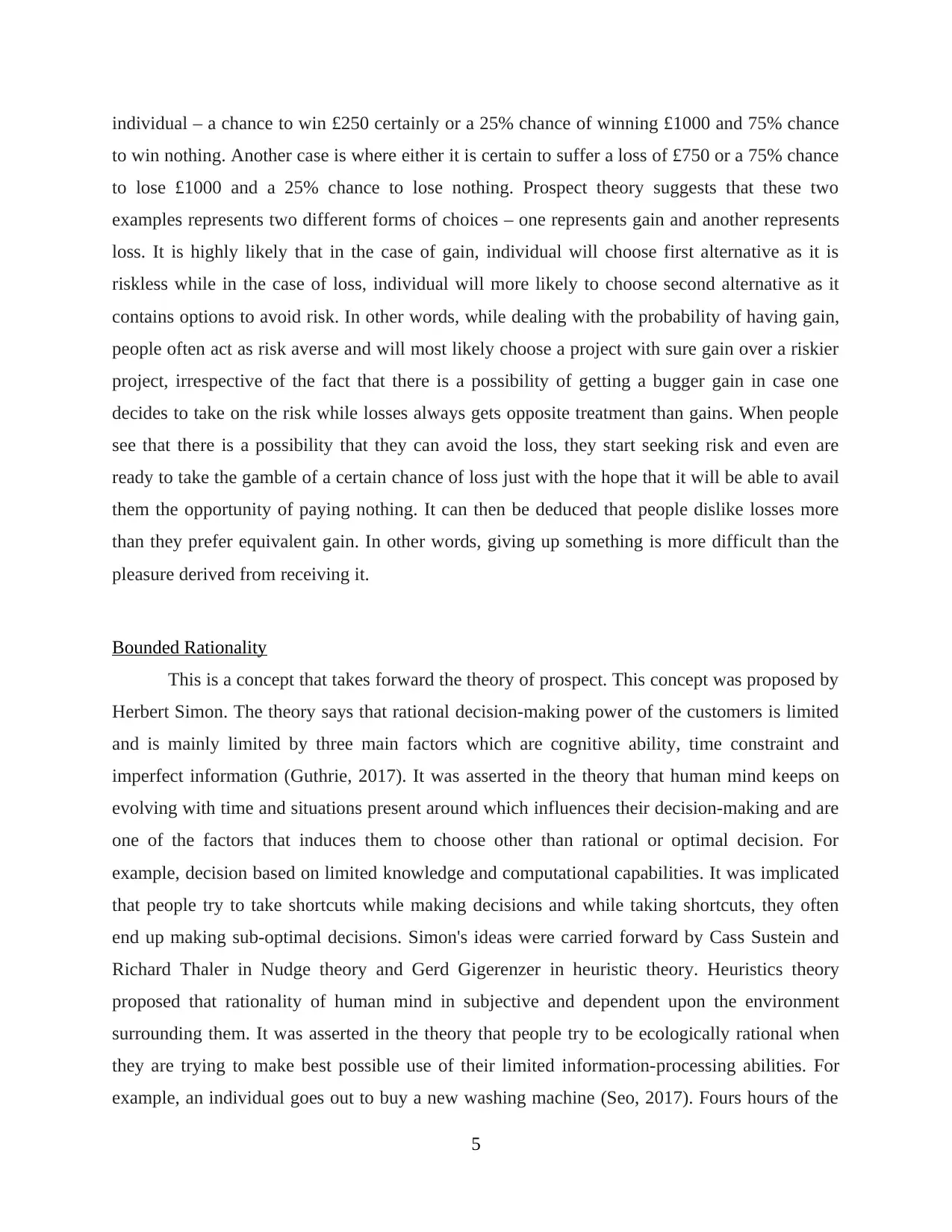
individual – a chance to win £250 certainly or a 25% chance of winning £1000 and 75% chance
to win nothing. Another case is where either it is certain to suffer a loss of £750 or a 75% chance
to lose £1000 and a 25% chance to lose nothing. Prospect theory suggests that these two
examples represents two different forms of choices – one represents gain and another represents
loss. It is highly likely that in the case of gain, individual will choose first alternative as it is
riskless while in the case of loss, individual will more likely to choose second alternative as it
contains options to avoid risk. In other words, while dealing with the probability of having gain,
people often act as risk averse and will most likely choose a project with sure gain over a riskier
project, irrespective of the fact that there is a possibility of getting a bugger gain in case one
decides to take on the risk while losses always gets opposite treatment than gains. When people
see that there is a possibility that they can avoid the loss, they start seeking risk and even are
ready to take the gamble of a certain chance of loss just with the hope that it will be able to avail
them the opportunity of paying nothing. It can then be deduced that people dislike losses more
than they prefer equivalent gain. In other words, giving up something is more difficult than the
pleasure derived from receiving it.
Bounded Rationality
This is a concept that takes forward the theory of prospect. This concept was proposed by
Herbert Simon. The theory says that rational decision-making power of the customers is limited
and is mainly limited by three main factors which are cognitive ability, time constraint and
imperfect information (Guthrie, 2017). It was asserted in the theory that human mind keeps on
evolving with time and situations present around which influences their decision-making and are
one of the factors that induces them to choose other than rational or optimal decision. For
example, decision based on limited knowledge and computational capabilities. It was implicated
that people try to take shortcuts while making decisions and while taking shortcuts, they often
end up making sub-optimal decisions. Simon's ideas were carried forward by Cass Sustein and
Richard Thaler in Nudge theory and Gerd Gigerenzer in heuristic theory. Heuristics theory
proposed that rationality of human mind in subjective and dependent upon the environment
surrounding them. It was asserted in the theory that people try to be ecologically rational when
they are trying to make best possible use of their limited information-processing abilities. For
example, an individual goes out to buy a new washing machine (Seo, 2017). Fours hours of the
5
to win nothing. Another case is where either it is certain to suffer a loss of £750 or a 75% chance
to lose £1000 and a 25% chance to lose nothing. Prospect theory suggests that these two
examples represents two different forms of choices – one represents gain and another represents
loss. It is highly likely that in the case of gain, individual will choose first alternative as it is
riskless while in the case of loss, individual will more likely to choose second alternative as it
contains options to avoid risk. In other words, while dealing with the probability of having gain,
people often act as risk averse and will most likely choose a project with sure gain over a riskier
project, irrespective of the fact that there is a possibility of getting a bugger gain in case one
decides to take on the risk while losses always gets opposite treatment than gains. When people
see that there is a possibility that they can avoid the loss, they start seeking risk and even are
ready to take the gamble of a certain chance of loss just with the hope that it will be able to avail
them the opportunity of paying nothing. It can then be deduced that people dislike losses more
than they prefer equivalent gain. In other words, giving up something is more difficult than the
pleasure derived from receiving it.
Bounded Rationality
This is a concept that takes forward the theory of prospect. This concept was proposed by
Herbert Simon. The theory says that rational decision-making power of the customers is limited
and is mainly limited by three main factors which are cognitive ability, time constraint and
imperfect information (Guthrie, 2017). It was asserted in the theory that human mind keeps on
evolving with time and situations present around which influences their decision-making and are
one of the factors that induces them to choose other than rational or optimal decision. For
example, decision based on limited knowledge and computational capabilities. It was implicated
that people try to take shortcuts while making decisions and while taking shortcuts, they often
end up making sub-optimal decisions. Simon's ideas were carried forward by Cass Sustein and
Richard Thaler in Nudge theory and Gerd Gigerenzer in heuristic theory. Heuristics theory
proposed that rationality of human mind in subjective and dependent upon the environment
surrounding them. It was asserted in the theory that people try to be ecologically rational when
they are trying to make best possible use of their limited information-processing abilities. For
example, an individual goes out to buy a new washing machine (Seo, 2017). Fours hours of the
5
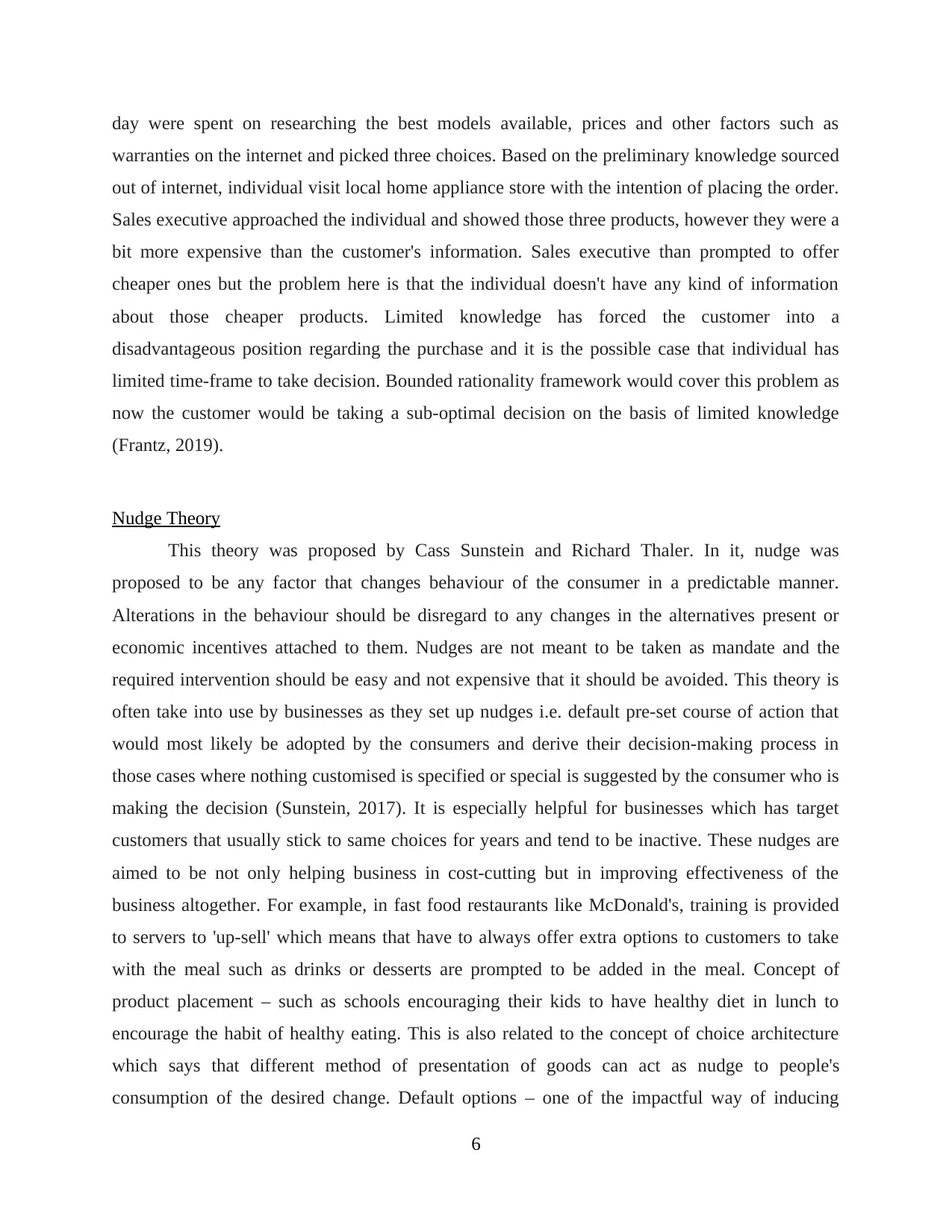
day were spent on researching the best models available, prices and other factors such as
warranties on the internet and picked three choices. Based on the preliminary knowledge sourced
out of internet, individual visit local home appliance store with the intention of placing the order.
Sales executive approached the individual and showed those three products, however they were a
bit more expensive than the customer's information. Sales executive than prompted to offer
cheaper ones but the problem here is that the individual doesn't have any kind of information
about those cheaper products. Limited knowledge has forced the customer into a
disadvantageous position regarding the purchase and it is the possible case that individual has
limited time-frame to take decision. Bounded rationality framework would cover this problem as
now the customer would be taking a sub-optimal decision on the basis of limited knowledge
(Frantz, 2019).
Nudge Theory
This theory was proposed by Cass Sunstein and Richard Thaler. In it, nudge was
proposed to be any factor that changes behaviour of the consumer in a predictable manner.
Alterations in the behaviour should be disregard to any changes in the alternatives present or
economic incentives attached to them. Nudges are not meant to be taken as mandate and the
required intervention should be easy and not expensive that it should be avoided. This theory is
often take into use by businesses as they set up nudges i.e. default pre-set course of action that
would most likely be adopted by the consumers and derive their decision-making process in
those cases where nothing customised is specified or special is suggested by the consumer who is
making the decision (Sunstein, 2017). It is especially helpful for businesses which has target
customers that usually stick to same choices for years and tend to be inactive. These nudges are
aimed to be not only helping business in cost-cutting but in improving effectiveness of the
business altogether. For example, in fast food restaurants like McDonald's, training is provided
to servers to 'up-sell' which means that have to always offer extra options to customers to take
with the meal such as drinks or desserts are prompted to be added in the meal. Concept of
product placement – such as schools encouraging their kids to have healthy diet in lunch to
encourage the habit of healthy eating. This is also related to the concept of choice architecture
which says that different method of presentation of goods can act as nudge to people's
consumption of the desired change. Default options – one of the impactful way of inducing
6
warranties on the internet and picked three choices. Based on the preliminary knowledge sourced
out of internet, individual visit local home appliance store with the intention of placing the order.
Sales executive approached the individual and showed those three products, however they were a
bit more expensive than the customer's information. Sales executive than prompted to offer
cheaper ones but the problem here is that the individual doesn't have any kind of information
about those cheaper products. Limited knowledge has forced the customer into a
disadvantageous position regarding the purchase and it is the possible case that individual has
limited time-frame to take decision. Bounded rationality framework would cover this problem as
now the customer would be taking a sub-optimal decision on the basis of limited knowledge
(Frantz, 2019).
Nudge Theory
This theory was proposed by Cass Sunstein and Richard Thaler. In it, nudge was
proposed to be any factor that changes behaviour of the consumer in a predictable manner.
Alterations in the behaviour should be disregard to any changes in the alternatives present or
economic incentives attached to them. Nudges are not meant to be taken as mandate and the
required intervention should be easy and not expensive that it should be avoided. This theory is
often take into use by businesses as they set up nudges i.e. default pre-set course of action that
would most likely be adopted by the consumers and derive their decision-making process in
those cases where nothing customised is specified or special is suggested by the consumer who is
making the decision (Sunstein, 2017). It is especially helpful for businesses which has target
customers that usually stick to same choices for years and tend to be inactive. These nudges are
aimed to be not only helping business in cost-cutting but in improving effectiveness of the
business altogether. For example, in fast food restaurants like McDonald's, training is provided
to servers to 'up-sell' which means that have to always offer extra options to customers to take
with the meal such as drinks or desserts are prompted to be added in the meal. Concept of
product placement – such as schools encouraging their kids to have healthy diet in lunch to
encourage the habit of healthy eating. This is also related to the concept of choice architecture
which says that different method of presentation of goods can act as nudge to people's
consumption of the desired change. Default options – one of the impactful way of inducing
6
⊘ This is a preview!⊘
Do you want full access?
Subscribe today to unlock all pages.

Trusted by 1+ million students worldwide
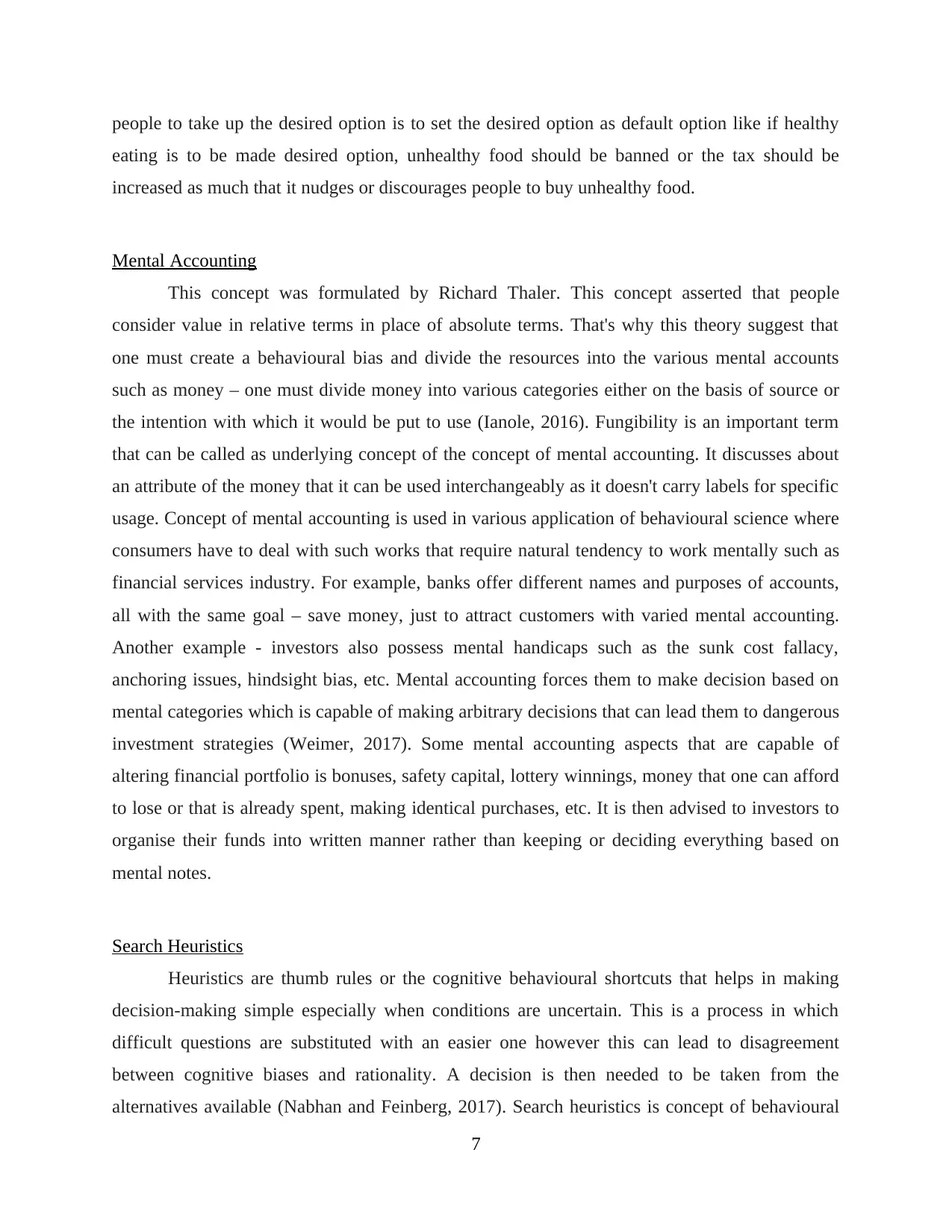
people to take up the desired option is to set the desired option as default option like if healthy
eating is to be made desired option, unhealthy food should be banned or the tax should be
increased as much that it nudges or discourages people to buy unhealthy food.
Mental Accounting
This concept was formulated by Richard Thaler. This concept asserted that people
consider value in relative terms in place of absolute terms. That's why this theory suggest that
one must create a behavioural bias and divide the resources into the various mental accounts
such as money – one must divide money into various categories either on the basis of source or
the intention with which it would be put to use (Ianole, 2016). Fungibility is an important term
that can be called as underlying concept of the concept of mental accounting. It discusses about
an attribute of the money that it can be used interchangeably as it doesn't carry labels for specific
usage. Concept of mental accounting is used in various application of behavioural science where
consumers have to deal with such works that require natural tendency to work mentally such as
financial services industry. For example, banks offer different names and purposes of accounts,
all with the same goal – save money, just to attract customers with varied mental accounting.
Another example - investors also possess mental handicaps such as the sunk cost fallacy,
anchoring issues, hindsight bias, etc. Mental accounting forces them to make decision based on
mental categories which is capable of making arbitrary decisions that can lead them to dangerous
investment strategies (Weimer, 2017). Some mental accounting aspects that are capable of
altering financial portfolio is bonuses, safety capital, lottery winnings, money that one can afford
to lose or that is already spent, making identical purchases, etc. It is then advised to investors to
organise their funds into written manner rather than keeping or deciding everything based on
mental notes.
Search Heuristics
Heuristics are thumb rules or the cognitive behavioural shortcuts that helps in making
decision-making simple especially when conditions are uncertain. This is a process in which
difficult questions are substituted with an easier one however this can lead to disagreement
between cognitive biases and rationality. A decision is then needed to be taken from the
alternatives available (Nabhan and Feinberg, 2017). Search heuristics is concept of behavioural
7
eating is to be made desired option, unhealthy food should be banned or the tax should be
increased as much that it nudges or discourages people to buy unhealthy food.
Mental Accounting
This concept was formulated by Richard Thaler. This concept asserted that people
consider value in relative terms in place of absolute terms. That's why this theory suggest that
one must create a behavioural bias and divide the resources into the various mental accounts
such as money – one must divide money into various categories either on the basis of source or
the intention with which it would be put to use (Ianole, 2016). Fungibility is an important term
that can be called as underlying concept of the concept of mental accounting. It discusses about
an attribute of the money that it can be used interchangeably as it doesn't carry labels for specific
usage. Concept of mental accounting is used in various application of behavioural science where
consumers have to deal with such works that require natural tendency to work mentally such as
financial services industry. For example, banks offer different names and purposes of accounts,
all with the same goal – save money, just to attract customers with varied mental accounting.
Another example - investors also possess mental handicaps such as the sunk cost fallacy,
anchoring issues, hindsight bias, etc. Mental accounting forces them to make decision based on
mental categories which is capable of making arbitrary decisions that can lead them to dangerous
investment strategies (Weimer, 2017). Some mental accounting aspects that are capable of
altering financial portfolio is bonuses, safety capital, lottery winnings, money that one can afford
to lose or that is already spent, making identical purchases, etc. It is then advised to investors to
organise their funds into written manner rather than keeping or deciding everything based on
mental notes.
Search Heuristics
Heuristics are thumb rules or the cognitive behavioural shortcuts that helps in making
decision-making simple especially when conditions are uncertain. This is a process in which
difficult questions are substituted with an easier one however this can lead to disagreement
between cognitive biases and rationality. A decision is then needed to be taken from the
alternatives available (Nabhan and Feinberg, 2017). Search heuristics is concept of behavioural
7
Paraphrase This Document
Need a fresh take? Get an instant paraphrase of this document with our AI Paraphraser
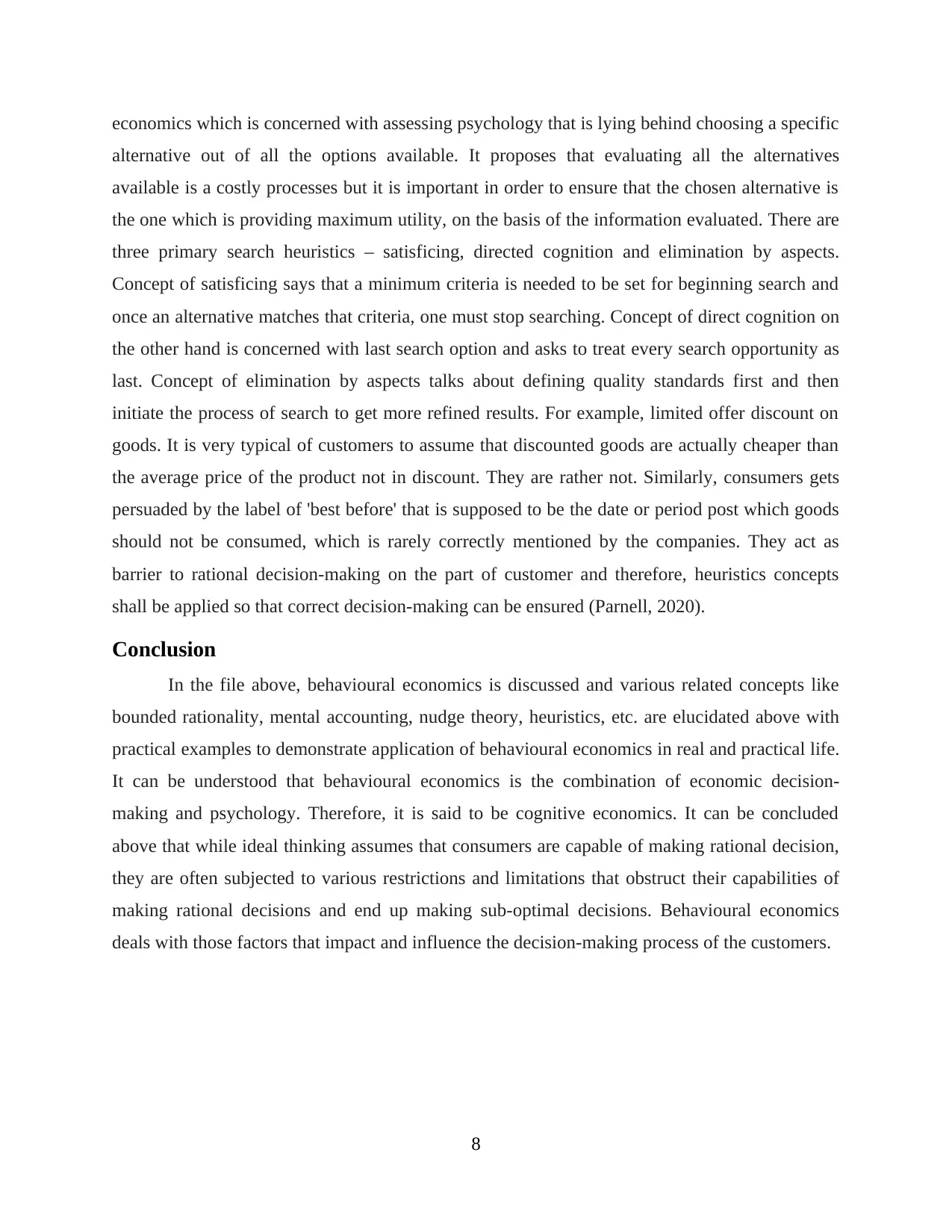
economics which is concerned with assessing psychology that is lying behind choosing a specific
alternative out of all the options available. It proposes that evaluating all the alternatives
available is a costly processes but it is important in order to ensure that the chosen alternative is
the one which is providing maximum utility, on the basis of the information evaluated. There are
three primary search heuristics – satisficing, directed cognition and elimination by aspects.
Concept of satisficing says that a minimum criteria is needed to be set for beginning search and
once an alternative matches that criteria, one must stop searching. Concept of direct cognition on
the other hand is concerned with last search option and asks to treat every search opportunity as
last. Concept of elimination by aspects talks about defining quality standards first and then
initiate the process of search to get more refined results. For example, limited offer discount on
goods. It is very typical of customers to assume that discounted goods are actually cheaper than
the average price of the product not in discount. They are rather not. Similarly, consumers gets
persuaded by the label of 'best before' that is supposed to be the date or period post which goods
should not be consumed, which is rarely correctly mentioned by the companies. They act as
barrier to rational decision-making on the part of customer and therefore, heuristics concepts
shall be applied so that correct decision-making can be ensured (Parnell, 2020).
Conclusion
In the file above, behavioural economics is discussed and various related concepts like
bounded rationality, mental accounting, nudge theory, heuristics, etc. are elucidated above with
practical examples to demonstrate application of behavioural economics in real and practical life.
It can be understood that behavioural economics is the combination of economic decision-
making and psychology. Therefore, it is said to be cognitive economics. It can be concluded
above that while ideal thinking assumes that consumers are capable of making rational decision,
they are often subjected to various restrictions and limitations that obstruct their capabilities of
making rational decisions and end up making sub-optimal decisions. Behavioural economics
deals with those factors that impact and influence the decision-making process of the customers.
8
alternative out of all the options available. It proposes that evaluating all the alternatives
available is a costly processes but it is important in order to ensure that the chosen alternative is
the one which is providing maximum utility, on the basis of the information evaluated. There are
three primary search heuristics – satisficing, directed cognition and elimination by aspects.
Concept of satisficing says that a minimum criteria is needed to be set for beginning search and
once an alternative matches that criteria, one must stop searching. Concept of direct cognition on
the other hand is concerned with last search option and asks to treat every search opportunity as
last. Concept of elimination by aspects talks about defining quality standards first and then
initiate the process of search to get more refined results. For example, limited offer discount on
goods. It is very typical of customers to assume that discounted goods are actually cheaper than
the average price of the product not in discount. They are rather not. Similarly, consumers gets
persuaded by the label of 'best before' that is supposed to be the date or period post which goods
should not be consumed, which is rarely correctly mentioned by the companies. They act as
barrier to rational decision-making on the part of customer and therefore, heuristics concepts
shall be applied so that correct decision-making can be ensured (Parnell, 2020).
Conclusion
In the file above, behavioural economics is discussed and various related concepts like
bounded rationality, mental accounting, nudge theory, heuristics, etc. are elucidated above with
practical examples to demonstrate application of behavioural economics in real and practical life.
It can be understood that behavioural economics is the combination of economic decision-
making and psychology. Therefore, it is said to be cognitive economics. It can be concluded
above that while ideal thinking assumes that consumers are capable of making rational decision,
they are often subjected to various restrictions and limitations that obstruct their capabilities of
making rational decisions and end up making sub-optimal decisions. Behavioural economics
deals with those factors that impact and influence the decision-making process of the customers.
8

References
Books and Journal
Wilkinson, N. and Klaes, M., 2017. An introduction to behavioral economics. Macmillan
International Higher Education.
Barberis, N., 2018. Richard Thaler and the rise of behavioral economics. The Scandinavian
Journal of Economics. 120(3). pp.661-684.
Wendel, S., 2020. Designing for behavior change: Applying psychology and behavioral
economics. O'Reilly Media.
Corr, P. and Plagnol, A., 2018. Behavioral Economics: The Basics. Routledge.
Guthrie, J. F., 2017. Integrating behavioral economics into nutrition education research and
practice. Journal of nutrition education and behavior. 49(8). pp.700-705.
Sunstein, C. R., 2017. Human Agency and Behavioral Economics: Nudging Fast and Slow.
Springer.
Ianole, R. ed., 2016. Applied Behavioral Economics Research and Trends. IGI Global.
Weimer, D. L., 2017. Behavioral economics for cost-benefit analysis: Benefit validity when
sovereign consumers seem to make mistakes. Cambridge University Press.
Nabhan, C. and Feinberg, B. A., 2017. Behavioral economics and the future of
biosimilars. Journal of the National Comprehensive Cancer Network. 15(12). pp.1449-
1451.
Parnell, J. A., 2020. The contribution of behavioral economics to crisis management decision-
making. Journal of Management and Organization. 26(4). pp.585-600.
Frantz, R., 2019. The Beginnings of Behavioral Economics: Katona, Simon, and Leibenstein's
X-efficiency Theory. Academic Press.
Seo, S. N., 2017. The behavioral economics of climate change: adaptation behaviors, global
public goods, breakthrough technologies, and policy-making. Academic Press.
Dhami, S., 2016. The foundations of behavioral economic analysis. Oxford University Press.
9
Books and Journal
Wilkinson, N. and Klaes, M., 2017. An introduction to behavioral economics. Macmillan
International Higher Education.
Barberis, N., 2018. Richard Thaler and the rise of behavioral economics. The Scandinavian
Journal of Economics. 120(3). pp.661-684.
Wendel, S., 2020. Designing for behavior change: Applying psychology and behavioral
economics. O'Reilly Media.
Corr, P. and Plagnol, A., 2018. Behavioral Economics: The Basics. Routledge.
Guthrie, J. F., 2017. Integrating behavioral economics into nutrition education research and
practice. Journal of nutrition education and behavior. 49(8). pp.700-705.
Sunstein, C. R., 2017. Human Agency and Behavioral Economics: Nudging Fast and Slow.
Springer.
Ianole, R. ed., 2016. Applied Behavioral Economics Research and Trends. IGI Global.
Weimer, D. L., 2017. Behavioral economics for cost-benefit analysis: Benefit validity when
sovereign consumers seem to make mistakes. Cambridge University Press.
Nabhan, C. and Feinberg, B. A., 2017. Behavioral economics and the future of
biosimilars. Journal of the National Comprehensive Cancer Network. 15(12). pp.1449-
1451.
Parnell, J. A., 2020. The contribution of behavioral economics to crisis management decision-
making. Journal of Management and Organization. 26(4). pp.585-600.
Frantz, R., 2019. The Beginnings of Behavioral Economics: Katona, Simon, and Leibenstein's
X-efficiency Theory. Academic Press.
Seo, S. N., 2017. The behavioral economics of climate change: adaptation behaviors, global
public goods, breakthrough technologies, and policy-making. Academic Press.
Dhami, S., 2016. The foundations of behavioral economic analysis. Oxford University Press.
9
⊘ This is a preview!⊘
Do you want full access?
Subscribe today to unlock all pages.

Trusted by 1+ million students worldwide
1 out of 9
Related Documents
Your All-in-One AI-Powered Toolkit for Academic Success.
+13062052269
info@desklib.com
Available 24*7 on WhatsApp / Email
![[object Object]](/_next/static/media/star-bottom.7253800d.svg)
Unlock your academic potential
Copyright © 2020–2025 A2Z Services. All Rights Reserved. Developed and managed by ZUCOL.





